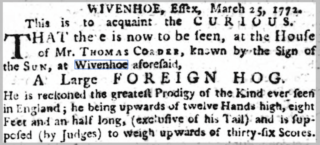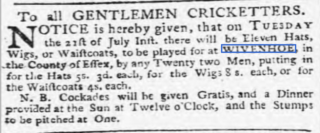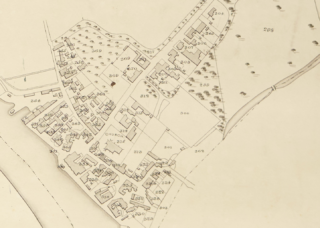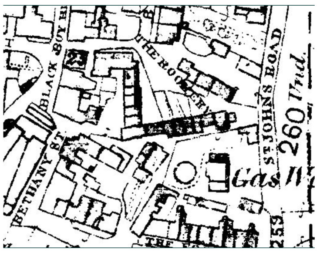About The Sun (18th Century – 1805)
One of Wivenhoe's least documented pubs in the vicinity of Brook Street
Terry Garland
The Pub Trail Index – click here
This is one of the least documented of Wivenhoe’s pubs and its location is only vaguely known. There is a known landlord from a newspaper article in the Ipswich Journal of 1772. In the 18th and 19th centuries there were two properties in Brook Street where the car park entrance to The Black Buoy now is. This, almost certainly, was the location of The Sun. In the late 19th century an L-shaped terrace of cottages was built behind The Black Buoy, the return extending through to St Johns Street. This was formerly known as The Rookery, now referred to as Sun Yard.
Known facts
There are few items that give reference to The Sun, its landlord or location.
The earliest found to date is the 1752 entry in a ledger relating to contributions to the poor listing a Mrs Hawse at The Sun, presumably she was the landlady.
An intriguing article in the Ipswich Journal of 28 March 1772 reports that there was to be seen, at the house of Mr. Thomas Corder, known by the Sign of the Sun, a large foreign hog, eight and a half feet long.
This gives us another landlord for The Sun. A Thomas Corder was the grandfather of Captain Thomas Corder Goodwin, landlord of The Black Buoy in the late 1800s, but that Thomas Corder was only born in 1772, it is likely, though not proven that his father was also Thomas and was the landlord referred to above.
An article in the Ipswich Journal of 18 July 1772 reports that on 21st July a cricket match was to be held with dinner at The Sun. From this it can be seen that The Sun was a substantial property capable of entertaining twenty-two cricketers and supporters.
An advertisement in the Ipswich Journal of 5 November 1785 refers to an auction of the furniture, fixtures etc of Charles Killingblet at the sign of the Sun in Wivenhoe, presumably following his death. The house was also to be sold or let and was described as with good conveniences for brewing.
A further clue comes from the notes taken by Nicholas Butler for his book The Story of Wivenhoe. An interview with Alice Gould (1887-1983) when she was 93, includes references to three houses in Brook Street opposite her cottage, now named Alice’s Cottage, and that she was born in The Sun although the notes do not expressly state that it was one of those three houses.
Location
One of the clues to the location of this public house is the name of the remaining cottage, to the rear of The Black Buoy car park, being Sun Yard. In the late 1800s there was a row of five cottages along the east side of the present car park, terminating in a warehouse. A second row of seven cottages ran from the rear of the warehouse through to St Johns Street. There was a sale on 16 February 1900 of the warehouse and 10 of the cottages under the Will of Mr. I. W. Goodwin. The warehouse, now a store room for The Black Buoy and one cottage to its rear, now named Sun Yard, are all that remain of those premises.
The 1838 Tithe Map of Wivenhoe shows the buildings on the corner of Brook Street. However only part of the group of cottages behind The Black Buoy existed. This, together with the assumption from the Nicholas Butler interview that The Sun was on Brook Street, gives strong evidence that The Sun was in the building on the corner of Brook Street.
The Sun was the symbol of Edward III, King of England from 1327-1377. Pub signs were often related to the signs of Kings but 1300s sounds a bit old for the first Sun pub here!
Landlords
There are a number of landlords recorded by Peter kay at The Sun, the reason for the often yearly turnover of landlords is unknown:
- 1769-1781 Thomas Corder (1733-1781) – he was the landlord of The Falcon from 1765-1769
- 1781 Sarah Corder (1740-1820) – widow of Thomas Corder
- 1782 John Savage
- 1783 Frank Bridge
- 1784 Francis Rudge (1732-1805)
- 1785 Charles Killingblet (his contents sold by auction 9 Nov 1785)
- 1790 John Bacon (1751-?)
- 1791 John Cadman
- 1792 Thomas Thorogood
- 1793 Samuel Battrum
- 1795 Thomas Lomere
- 1796 William Cole
The Corder family, and by marriage to the Goodwins, were connected to a number of the public houses in Wivenhoe. The Falcon, Grosvenor Hotel, Black Buoy and Station Hotel were all run at one time by them. A William Cole was landlord of The Yachter’s Arms in 1896, The Bull in 1901 and The Flag in 1904.
Links to other pages on this website:
General Sources:
- Butler N, “The Story of Wivenhoe”, Quentin Press Wivenhoe, 1989.
- British Newspaper Archive
- Essex Church of England Parish Registers. Chelmsford, Essex Record Office
- Kay P, “Wivenhoe Pubs”, published by Peter Kay 2003.
The Pub Trail Index – click here










No Comments
Add a comment about this page